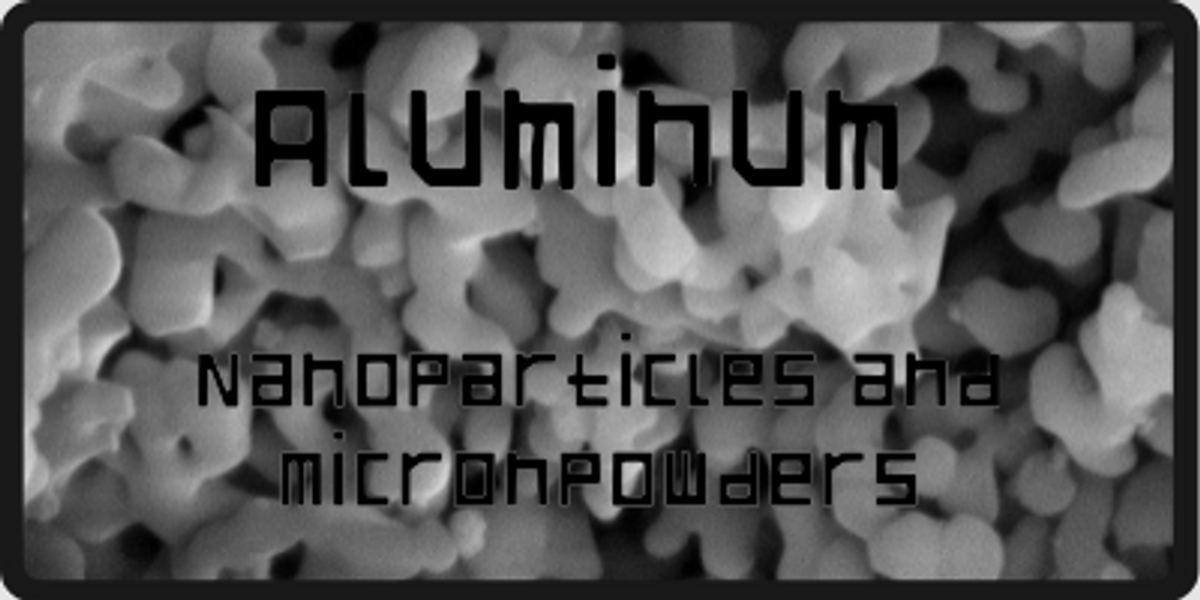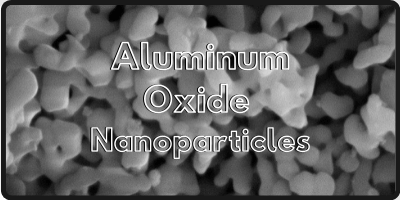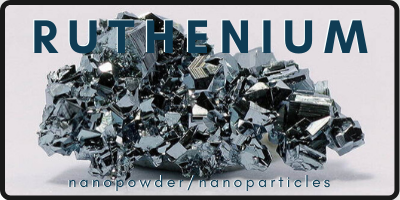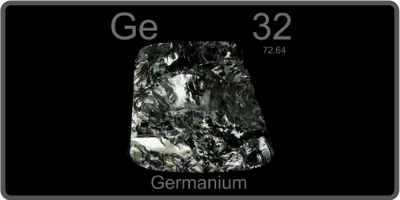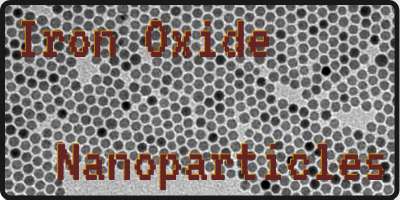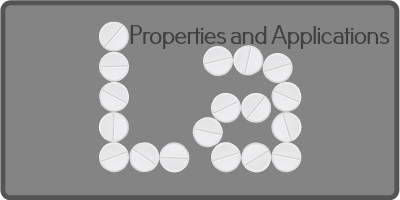Facts about Aluminum (Al) Nanoparticles/Nanopowder
Aluminum is the third most abundant element in the earth's crust. Aluminum is a well-known metal because it is present in many objects that we handle daily: cans, etc. Its properties make it also very interesting for industrial applications in the automotive and aeronautical sectors, where it is used in alloys. In this article, we will present various properties and applications of aluminum.
Aluminum, of atomic number 13 and chemical symbol Al, belongs to the elements of Group 13 of the periodic table. It is the third most abundant element of the earth's crust (8%), after silicon (27.7%) and oxygen (46.6%). In its natural state, it is never free but combined with elements such as oxygen, fluoride, and silicon, thus forming minerals.
Aluminum exists in many sectors of the world economy. Its large-scale production dates back more than 140 years ago when the Bayer process was applied as an industrial method to produce aluminum from the dissolution of bauxite in sodium hydroxide and subsequent electrochemical treatment. This process, even when it is expensive, is now, and worldwide, the industrial way to obtain aluminum. Since the mid-twentieth century, aluminum has been the most used metal, after steel.
Origin
The chemical element aluminum is abundant in the earth's crust. On the other hand, since it readily oxidizes in the presence of oxygen, almost all of the aluminum found in nature is oxidized, mainly in the form of alumina Al2O3. Alumina is particularly present in a rock called bauxite. This name comes from the fact that it was discovered in the village of Baux-de-Provence, France, in 1822. The red coloration of this rock is due to the iron oxides it contains. Bauxite is the most commonly used ore to produce aluminum.
Properties of Aluminum
The demand for aluminum products or incorporating aluminum in their composition continues to grow year after year. Beyond world population growth and the increase in purchasing power in emerging countries, aluminum consumption is also increasing in Europe and France through the substitution effect (aluminum is gradually replacing other materials) thanks to a unique combination of properties such as lightness, mechanical strength, and corrosion resistance, conductivity, ductility, recyclability, and many other properties.
Mechanical resistance
Aluminum is mainly used in the form of alloys, the main constituent of which is aluminum. The strength of the aluminum alloy is adapted to the required application. For example, it is considered that one kilogram of aluminum can replace two kilograms of steel in automotive applications.
Lightness
Aluminum is a very light metal with a specific density of 2.7 g/cm3, about a third of that of steel (7-8 g/ cm3) or copper (8.96 g/cm3).
Corrosion Resistance
Aluminum naturally generates an oxide layer that protects it from corrosion. Different types of surface treatment can further improve this resistance (anodizing, lacquering, etc.).
Ductility and Malleability
Aluminum can be easily worked at low temperatures and deformed without breaking, which allows it to give a wide variety of shapes.
Thermal and Electrical Conductivity
Aluminum is an excellent conductor of heat and electricity. The thermal conductivity of aluminum is used in many applications of heat dissipation, i.e. cooling (such as air conditioning systems in vehicles).
For the same weight, aluminum offers an electrical conductivity twice that of copper, which explains its privileged use in high voltage electricity transmission over long distances.
Recyclability
Aluminum is 100% recyclable without degrading its properties. Its recycling requires only little energy: only 5% of the energy used for the production of primary metal.
Waterproofing
Even at very low thickness, an aluminum sheet is completely waterproof and does not allow light, micro-organisms or odors to pass through. In addition, the metal itself does not release any odor or taste, making it an element of choice for food or pharmaceutical packaging.
Click Images to Read About Aluminum Oxide Nanoparticles
Importance of Aluminum
The industrial importance of aluminum lies in the versatility conferred by its physical and chemical properties. It is a soft metal, of low density, malleable, ductile, of low mechanical resistance, little tendency to oxidation in the presence of oxygen, resistant to corrosion and conductor of the electric current. Its excellent weight/resistance ratio has been improved, through alloys for the construction of airplanes, vehicles and other means of transport. In addition, its malleability allows it to be melted and emptied into various molds to obtain laminates or very thin sheets.
The widespread use of aluminum and its alloys encompasses a wide variety of products. The main markets for aluminum and its alloys include packaging materials, cans, aluminum foil, food packaging, and kitchen utensils, among others. The construction industry uses it for the manufacture of window frames, doors, locks, drainage channels, and coatings. The automotive and aerospace industries use aluminum alloys for the production of auto parts, aircraft manufacturing, rockets, fuselages, coatings, and other components. As for the household appliances sector, it uses large-scale metal in the manufacture of refrigerators, washing machines, dryers, among others.
On the other hand, its use reaches the development of a variety of chemical applications for the production of paints and pigments based on aluminum oxide, abrasives, refractories, ceramics, electrical insulators, alloys, artificial gems, spark plugs, heat resistant fibers, rocket fuels, additives, explosives, among others. The pharmaceutical, food and cosmetic industries also use preparations with aluminum, which include preservatives, dyes, emulsifying agents, antiperspirants, adjuvants, drug coating, among others. Aluminum salts are also used for water purification, sugar refining, beer brewing, and papermaking.
Now, aluminum is the only fully recyclable metal. Currently, its recovery has become an important aspect of the worldwide aluminum production industry; more than seven million tons of metal are recovered annually.
Applications of Aluminum
Aluminum has a lot of applications. Spun aluminum parts are among those most commonly used in the manufacturing industry. They are found in many everyday applications ranging from cars to planes, from office furniture to light fixtures to name a few. The lightness, durability, and malleability of aluminum make it the preferred material for suitable structures and finishes (natural and shiny, powder-coated, electroplated, or anodized).
Aluminum has many advantages over other materials. Beyond its good strength and weight ratio, it does not corrode like steel and can be recycled in a more efficient and environmentally friendly way. A product made of aluminum compared to that traditionally made of steel or plastic, over its entire life cycle, is often less expensive and more ecological because it also requires less machining and assembly time.
Let’s discuss some modern applications of aluminum:
The Aluminum Chassis
Audi (the Audi A8) revolutionized the chassis design by marketing the aluminum A8 model in 1994. This choice was confirmed by the brand with the marketing of other models, such as by Jaguar, a manufacturer competitor. The construction of an aluminum chassis requires specific and innovative technologies.
The Mars MER Robot
Rovers powered by solar energy can move 40 meters per Martian day and the engineers' mission was to design the lightest wheels possible - resistant and flexible - so as not to add to the weight of the spacecraft. With 26 centimeters in diameter, these aluminum wheels were twice the size of those of Sojourner and were able to withstand Martian rocks.
Wiring
Aluminum and certain alloys have gradually replaced copper in the transmission and distribution of electricity. Today, almost all electrical networks in Canada and the United States are made of aluminum or aluminum alloys, bare or insulated, as well as a large number of underground cables.
This metal weighs only a third of copper and, for equal weight, it can transport twice as much electricity because of its high conductivity. Transport lines are therefore lighter and require fewer pylons. The aluminum wires are placed on lighter pylons.
An aluminum conductor can consist of several braided wires or, to increase resistance, aluminum wires around a steel cable. The bars which carry the current between the transformers and the rectifiers are also made of aluminum.
The use of aluminum also makes it possible to reduce the "corona effect" which generates losses (dielectric losses). This effect can be reduced by increasing the diameter of the conductor, an operation made easier by the lightness of the aluminum.
Aluminum is used in the manufacture of electrical products: bulb base, for example as well as television antennas. Very resistant to corrosion, robust and flexible, aluminum is antimagnetic, a precious quality for electrical applications.
Apple PowerBook G4
The PowerBook G4 Apple is the first computer laptop in the world to incorporate a 17-inch screen, has a rugged alloy of aluminum lightweight. The laptop is less than 2.6 cm thick and just over 3 kg. The lifespan of aluminum housing is, of course, much greater than that of a plastic equivalent.
New BMW 5 Series
The release of a new model accompanies the spread of new technologies. The 5 Series is the first car with a variable reduction steering and a chassis combining steel and aluminum. Other new technologies: head-up display, adaptive directional lighting, Dynamic Drive suspension, and adaptive front and rear lights.
Thanks to the compact aluminum rear axle, the wheels are guided by four aluminum arms fixed elastically to the axle cradle. The latter is itself fixed to the body using elastic bearings. The geometry of the arms is designed in such a way as to obtain a precisely defined turning of the rear wheels, exemplary heading stability and directional stability as well as a great insensitivity to load transfers.
In the event of a side-impact, the doors are fitted with aluminum reinforcements placed diagonally and supplemented by pins retaining the doors. This provides very high rigidity and effectively reduces the risk of foreign bodies entering the passenger compartment.
In conclusion, Aluminum is the most recently discovered metal since it has only been used industrially since the end of the 19th century. Aluminum has entered its industrial phase; its production has experienced tremendous growth in 100 years, placing it at the forefront of non-ferrous metals and the second of all metals behind iron. Aluminum, one of the metals most used by modern industry, is due to the combination of the many optimal properties that constitute it. Aluminum has a low specific gravity; this characteristic provides great advantages in numerous industrial applications. The diversity of alloys makes it possible to use aluminum in many applications which can be very different, including forging. Moreover, Aluminum is very easy to deform, the machinability of certain aluminum alloys can be absolutely comparable to that of brass. In the end, Aluminum has an excellent specific electrical conductivity, which makes it essential for electrical and electronic applications.
Click Images to Read Our Other Articles on Nanoparticles
References
https://www.sciencedirect.com/science/article/pii/...
https://www.researchgate.net/publication/320310024...
https://www.researchgate.net/publication/328252678...
https://www.sciencedirect.com/topics/engineering/a...
Recent Posts
-
Nanocomposites in Food Packaging
The utilization of nanocomposites in food packaging represents a significant advancement in the fiel …19th Apr 2024 -
What is the Difference Between 7075 and 6061 Aluminum Alloy?
When comparing 7075 aluminum alloy to 6061 aluminum alloy, it's essential to understand their disti …5th Apr 2024 -
Iron-Air Batteries: The Ultimate Guide
Iron-air batteries represent a significant breakthrough in energy storage technology, offering a sus …29th Mar 2024

